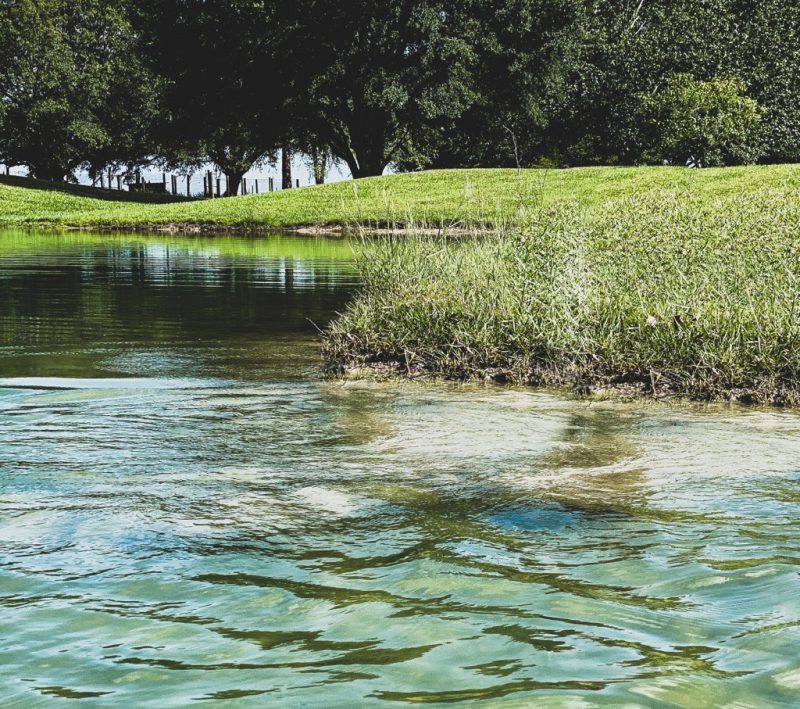Typically, when we think of ponds we think of Summertime, a hot sunny day, and a fishing pole. However, as seasons change so should our management mindset to ensure a healthy pond throughout the year.
Like our trees that loose their leaves, ponds are also influenced by shorter days, colder temperatures, and fading foliage. These conditions influence the biological and ecological characteristics in your pond, which in turn affect the wildlife, plants and organisms that inhabit the pond.

Shorter days, colder temperatures, and fading foliage influence the biological and ecological characteristics in your pond, which in turn affect the wildlife, plants and organisms that inhabit the pond. Credit Madelyn Godwin, UF/IFAS
–
Elements of Winter Pond Management
–
Fish Behavior
The behavior of the fish can tell you a lot about your pond’s wellbeing. Fish are cold blooded; and are not able to maintain a constant body temperature like mammals. Pond temperature controls fish body temperature, as well as their metabolism and activity level. Fish are more active in warmer weather and tend to feed more in summer rather than winter.
–
Dissolved Oxygen (D.O.)
D.O. is a vital component of pond health. As the name implies D.O. is oxygen gas that has dissolved in water. It is absorbed through the gills of the fish. D.O. in a pond is used by not only the fish to breathe, but also by pond plants, animals, and bacteria for many natural processes. We know that in winter temperatures will drop, therefore making the pond water cooler. As water cools it is able to hold more D.O., which is generally viewed as a positive in relation to pond health/management. Conversely, short winter days equate to reduced sunlight for photosynthesis and less ability for plants to oxygenate the pond water. North Florida winter temperatures tend to fluctuate considerably, this could lead to a situation where water temperatures (especially in small/shallow ponds) rise while days are still short causing potential D.O. concerns. Bacterial decomposition processes, which consume D.O., will also increase as water temperature increase. In ponds with excessive decaying organic matter, this could also present a D.O. challenge.
–
Nitrates
Nitrates are another important component of pond health. High volumes of nitrate can occur in heavily stocked ponds when the weather temperatures are fluctuating. This in turn can disturb the beneficial nitrogen cycle and cause “brown blood disease.” This disease is caused by fish absorbing excessive amounts of nitrogen through their gills, which turns their blood a brownish color, causing suffocation as a result of lack of dissolved oxygen intake.
–
Management
Feed Reduction– Lower temperatures (60 degrees or below) reduce activity in the pond. Therefore, you should reduce the amount of feed provided for the fish in the winter. With fish feeding less, uneaten food will add unwanted organic matter that can cause low oxygen levels which can lead to a fish kill.
Aerator– Watch your fish for oxygen stress! This is when an aerator comes in handy. Keeping it active during the winter can help manage dissolved oxygen levels.
Call Your Agent– If you are not sure where to begin call your county extension agent. They can help guide you in the right direction. Most offices have pond kits to evaluate water quality.
Organic Matter removal- when removing dead/decaying plants from around your pond, be sure to dispose of it elsewhere. Do not throw them back into the pond. This action can cause an oxygen depletion from excess organic matter needing to be decomposed.
–
Additional Information & References used for this article:
Managing Florida Ponds for Fishing
Dissolved Oxygen for Fish Production
Nitrite Poisoning or “Brown Blood” Disease a Preventable Problem
Fish Health Management Considerations in Recirculating Aquaculture Systems
The Role of Aeration in Pond Management
- Cotton Nitrogen Fertilization Rate Study 2023 Mid-Season Update - July 21, 2023
- Winter Pond Management - December 16, 2022
